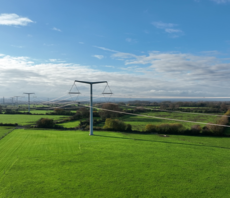T-pylons: National Grid electrifies first low-carbon pylon project


The UK’s first new pylon design for nearly 100 years was powered up this week, in a landmark moment for the National Grid’s Hinkley Connection Project in Somerset.
New T-shaped electricity pylons are now carrying up to 400,000 volts of electricity to homes and businesses between Bridgewater and Loxton, after National Grid this week cut the ribbon on its latest landmark project.
The new pylons were powered up for the first time this week, marking the culmination of a lengthy project to design and develop new pylons that are shorter, less visually intrusive, and more environmentally friendly than the UK’s traditional lattice pylons.
The development is also a major milestone for the Hinkley Connection Project, which aims to connect six million buildings in the South West to local, low carbon energy supplies, including the Hinkley Point C nuclear power station currently under construction in the area.
“We’re extremely proud to have reached this significant milestone on the Hinkley Connection Project,” said Steven Haskayne, project director at National Grid. “The T-pylons are now reinforcing and strengthening the network in the South West and are ready for the connection of low carbon energy when Hinkley Point C starts generating.
“This new design forms part of our significant investment in the network in England and Wales, adding capacity onto the grid to deliver low carbon electricity to millions of people across the UK to use for years to come, and helping the UK’s journey towards net zero.”
The T-pylons were electrified along with 8.5km of underground cables in the Mendip Hills Area of Outstanding Beauty and a new electricity substation in Sandford. A further 80 T-pylons are to be completed and energised in the area by 2024.
There are also plans to integrate T-pylon technology elsewhere in the National Grid.
Andrew Bowie, Minister for Nuclear and Networks, said he was looking forward to visiting the site “to see first-hand their innovative network infrastructure that is placing the South West at the heart of the UK’s plans to deliver green growth and energy security”.
Though construction on the T-pylons only started in 2021, the project has been 12 years in the making.
The idea to use T-pylons emerged from a competition in 2011 organised by the Royal Institute of British Architects and the then Department of Energy and Climate Change, which selected the Danish architect Bystrup’s designs on the grounds they offered significant resource efficiency improvements.
The T-shaped structures with diamond shaped conductors have fewer parts than conventional pylons, are just 35 metres high – 10 to 15 metres shorter than lattice towers – and have a smaller ground footprint, requiring less raw material.















